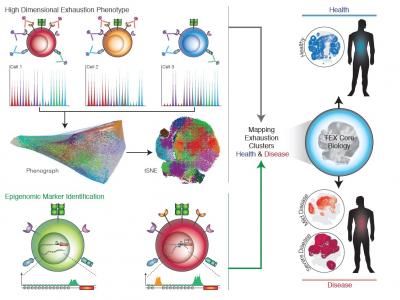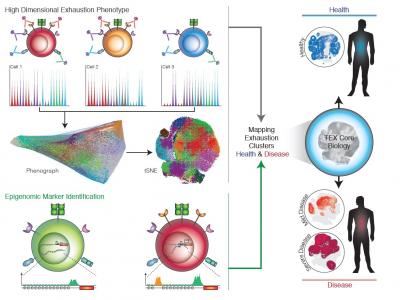
Credit: John Wherry, Perelman School of Medicine at the University of Pennsylvania; Immunity
PHILADELPHIA – The battle between the human immune system and long-term, persisting infections and other chronic diseases such as cancer results in a prolonged stalemate. Over time battle-weary T cells become exhausted, giving germs or tumors an edge. Using data from multiple molecular databases, researchers from the Perelman School of Medicine at the University of Pennsylvania have found nine distinct types of exhausted T cells ("Tex"), which could have implications for fighting chronic infections, autoimmunity, and cancer. They published their findings in Immunity this week.
"Exhausted T cells are a discrete cell lineage that have become important immunotherapy targets for chronic infection and cancer," said senior author John Wherry, PhD, a professor of Microbiology and director of the Institute for Immunology. "Now, we know that exhausted T cells are a vastly diverse set of immune cells."
Wherry's lab has spent the last decade describing these populations of fatigued cells. Overall, when normal T cells become exhausted, they develop defects in their germ- and tumor-fighting capabilities. Tex also express inhibitory receptor proteins on their surface that stall key biochemical pathways, provoke changes in control of gene expression, alter metabolism for making energy to fight infections and tumors, and prevent development of optimal immune function.
New, highly effective immunotherapies that target these inhibitory receptors expressed by Tex such as PD-1 or CTLA-4 have shown dramatic effects among patients with melanoma and other diseases, with potential to also combat breast, ovarian and other cancers. Although Tex have been implicated in the response to checkpoint blockade drugs in animal models, the underlying immunological mechanisms of their therapeutic response or failure in people is only now being studied in earnest.
"Exhausted T cells are quite diverse, as are all types of T cells," Wherry said. "This sheer diversity is the hallmark of the human immune system that has to essentially have a way to respond to every germ an individual might encounter in a lifetime."
Knowing this, the Penn team asked what the diversity in the Tex pool reveals about a disease itself and its course in a patient. They developed an assay to investigate the molecules that control gene expression in Tex by comparing them to other types of T cells and within a Tex population in blood from HIV patients whose viral load is well-controlled.
Next, they defined core exhaustion-specific genes and identified disease-induced molecular changes in Tex populations in HIV with uncontrolled disease and in human lung cancer. Using this data, the Tex fell into nine distinct clusters of similar expression patterns with regard to transcription factors and inhibitory receptors.
Because of the clusters' relationships to specific disease type and progression, the team's aim is to use the signature of a Tex cluster to assess a patient's overall immune health and likelihood of responding to a certain therapy. "We want to be able to select and tailor immune therapies according to a patient's exhausted T cell pool and its individual characteristics," Wherry said.
Applying this type of assessment to exhausted T cells in the context of immunotherapy clinical trials might identify patients more likely to benefit from specific types of combination immunotherapies and may point to underlying mechanisms in the specific types of exhausted T cells responding to an infection or cancer.
###
These studies were led by first author Bertram Bengsch, a postdoctoral fellow in Wherry's lab. Other coauthors from Penn included Takuya Ohtani, Omar Khan, Sasikanth Manne, Shaun O'Brien, Ramin Sedaghat Herati, Alexander C. Huang, Kyong-Mi Chang, and Steven M. Albelda.
This work was supported in part by the National Institutes of Health (AI105343, AI082630, AI112521, AI115712, AI117718, AI108545, and AI117950) and the Parker Institute for Cancer Immunotherapy.
Penn Medicine is one of the world's leading academic medical centers, dedicated to the related missions of medical education, biomedical research, and excellence in patient care. Penn Medicine consists of the Raymond and Ruth Perelman School of Medicine at the University of Pennsylvania (founded in 1765 as the nation's first medical school) and the University of Pennsylvania Health System, which together form a $7.8 billion enterprise.
The Perelman School of Medicine has been ranked among the top medical schools in the United States for more than 20 years, according to U.S. News & World Report's survey of research-oriented medical schools. The School is consistently among the nation's top recipients of funding from the National Institutes of Health, with $405 million awarded in the 2017 fiscal year.
The University of Pennsylvania Health System's patient care facilities include: The Hospital of the University of Pennsylvania and Penn Presbyterian Medical Center — which are recognized as one of the nation's top "Honor Roll" hospitals by U.S. News & World Report — Chester County Hospital; Lancaster General Health; Penn Medicine Princeton Health; Penn Wissahickon Hospice; and Pennsylvania Hospital – the nation's first hospital, founded in 1751. Additional affiliated inpatient care facilities and services throughout the Philadelphia region include Good Shepherd Penn Partners, a partnership between Good Shepherd Rehabilitation Network and Penn Medicine, and Princeton House Behavioral Health, a leading provider of highly skilled and compassionate behavioral healthcare.
Penn Medicine is committed to improving lives and health through a variety of community-based programs and activities. In fiscal year 2017, Penn Medicine provided $500 million to benefit our community.
Media Contact
Karen Kreeger
[email protected]
215-459-0544
@PennMedNews
http://www.uphs.upenn.edu/news/






